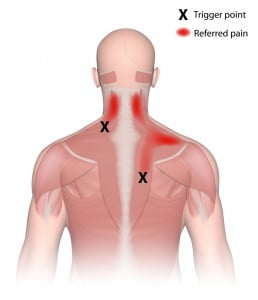How Does a Trigger Point Cause Pain?
A trigger point is described as hyperirritable spots in skeletal muscle that are associated with palpable nodules in taut bands of muscle fibers.

The trigger point model states that unexplained pain frequently radiates from these points of local tenderness to broader areas, sometimes distant from the actual point itself. Practitioners claim to have identified reliable referred pain patterns that associate pain in one location with trigger points elsewhere. There is variation in the methodology for the diagnosis of trigger points and a dearth of theory to explain how they arise and why they produce specific patterns of referred pain.
The compression of a trigger point may elicit local tenderness, referred pain, or local twitch response. It may even feel like pressure is being used in an area not being touched. The local twitch response is not the same as a muscle spasm. This is because a muscle spasm refers to the entire muscle contracting whereas the local twitch response also refers to the entire muscle but only involves a small twitch, no contraction.
To release these painful spots massage therapists like to use what we call a pressure stretch. We put pressure on the spot and hold it for several seconds so that it can stretch out and relax. Sometimes too much pressure is used and it causes the opposite effect. Make sure even though it is painful that you can still relax through the pain. If you can’t, tell your therapist to use less pressure. On the flip side, you’d be amazed at how much your body can respond with little pressure. So it really doesn’t HAVE to hurt to work!
Please give us a call to help relieve your pain! 614-604-6358
From Wikipedia*






